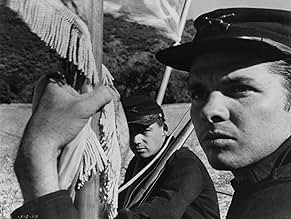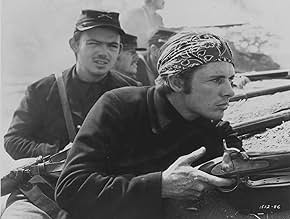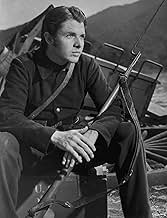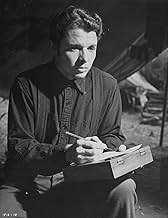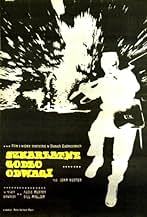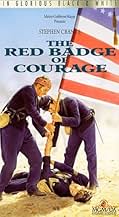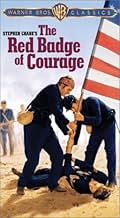Truncated adaptation of Stephen Crane's novel about a Civil War Union soldier who stuggles to find the courage to fight in the heat of battle.Truncated adaptation of Stephen Crane's novel about a Civil War Union soldier who stuggles to find the courage to fight in the heat of battle.Truncated adaptation of Stephen Crane's novel about a Civil War Union soldier who stuggles to find the courage to fight in the heat of battle.
- Nominated for 1 BAFTA Award
- 1 win & 1 nomination total
Robert Easton
- Thompson
- (as Robert Easton Burke)
Don Anderson
- Soldier
- (uncredited)
Smith Ballew
- Union Captain
- (uncredited)
Albert Band
- Union Soldier Fording River
- (uncredited)
Gregg Barton
- Soldier
- (uncredited)
Whit Bissell
- Wounded Officer
- (uncredited)
Robert Board
- Soldier
- (uncredited)
Chet Brandenburg
- Wounded Soldier
- (uncredited)
Edwin Breen
- Confederate Flag Bearer
- (uncredited)
Joe Brown Jr.
- Soldier
- (uncredited)
- Director
- Writers
- All cast & crew
- Production, box office & more at IMDbPro
Storyline
Did you know
- TriviaAfter seeing what MGM had done to the film, John Huston instructed his agent to include a clause in all future contracts guaranteeing that he would receive a copy of his director's cut on all of his films.
- GoofsAll the soldiers in Audie's infantry outfit have crossed rifles on their forage hats. The crossed rifle insignia was not adopted by the US army until the year 1876, before this it was a hunter's horn.
- Quotes
The General: Howdy Jim, Corporal. How are those wounds?
Soldier: Stinging some, General, but they're a-mending.
The General: That's fine, fine. Anybody care for a chaw?
- ConnectionsEdited into Hollywood: The Dream Factory (1972)
Featured review
Such a darn shame so much of the film was lost during a power struggle at MGM. What remains is a strong drama adapted from the Crane novel. Some call it an anti-war film, but that's a stretch since Audie Murphy's youthful soldier proves himself in battle after a cowardly initiation, and receives the admiration of his buddies. The sequence is more like a rite of passage than a denunciation.
The somewhat amateur cast is outstanding. I expect the untrained Murphy felt a personal commitment to his role and comes through just as professionally as he did in real life. Untrained cartoonist Bill Mauldin also looks and acts the part of callow youth maturing under pressures of life or death situations. His big ears are especially persuasive for a Hollywood setting.
And what burst of inspiration led the normally glamor-obsessed Tiffany of Studios to cast such affecting unlovelies as John Dierkes and Royal Dano in key parts. It's Dierkes's ill-fated salt-of-the-earth soldier that injects real tragedy into the sparse dialogue. With his craggy face and towering body he's every inch the early American primitive. And, of course, there's Dano with his gaunt face, wasted body, and graveyard voice, who helps make that line of wounded soldiers (the real core of the film) an unforgettable procession. Nor should that genuine face of war, the battle-shocked soldier deliriously bellowing The Battle Hymn of the Republic as he trudges along, be overlooked. And for a little humorous relief, who can forget the general whose pep-talk to each unit sounds like a broken record with a big stomach, but whose humanity shines through anyway.
The sweeping battlefields are effective in their look and feel, even if it is the scrublands of SoCal in the distance. Note all the dust and smoke obscuring vision, along with the chaotic criss-crossing of other units going here and there, but we don't know where. The effect is that of focusing our concerns on the familiar faces rather than on who's winning or losing the battle, which, I gather, is the way most infantry experience battle. It's been called understandably "the fog of war".
I like the brief lyrical moments that remind us of a larger world outside the stage of human conflict. Actually, Murphy is quite good at portraying sensitivity, as for example when he turns away from the raucous byplay at the farm house. The quiet moments with him and Mauldin are rather touching in that they look like two average Joe's showing the personal side of war. But, as Murphy proved in both the movie and real life, you never know the depths that may be concealed under that ordinary appearance.
I believe it was critic Andrew Sarris who pointed out that John Huston's career was never the same after MGM got through editing out an hour of his version and throwing the rest away. Now we can only guess how many other affecting scenes were tossed out in the process. Obviously, the project was close to Huston's heart being an adaptation of a great American novel from its most wrenching national conflict. I don't know whether to be happy or sad that this severely truncated version was finally marketed. It's good, but then there's the promise of so much more. Too bad the production didn't migrate to a less image-conscious studio.
The somewhat amateur cast is outstanding. I expect the untrained Murphy felt a personal commitment to his role and comes through just as professionally as he did in real life. Untrained cartoonist Bill Mauldin also looks and acts the part of callow youth maturing under pressures of life or death situations. His big ears are especially persuasive for a Hollywood setting.
And what burst of inspiration led the normally glamor-obsessed Tiffany of Studios to cast such affecting unlovelies as John Dierkes and Royal Dano in key parts. It's Dierkes's ill-fated salt-of-the-earth soldier that injects real tragedy into the sparse dialogue. With his craggy face and towering body he's every inch the early American primitive. And, of course, there's Dano with his gaunt face, wasted body, and graveyard voice, who helps make that line of wounded soldiers (the real core of the film) an unforgettable procession. Nor should that genuine face of war, the battle-shocked soldier deliriously bellowing The Battle Hymn of the Republic as he trudges along, be overlooked. And for a little humorous relief, who can forget the general whose pep-talk to each unit sounds like a broken record with a big stomach, but whose humanity shines through anyway.
The sweeping battlefields are effective in their look and feel, even if it is the scrublands of SoCal in the distance. Note all the dust and smoke obscuring vision, along with the chaotic criss-crossing of other units going here and there, but we don't know where. The effect is that of focusing our concerns on the familiar faces rather than on who's winning or losing the battle, which, I gather, is the way most infantry experience battle. It's been called understandably "the fog of war".
I like the brief lyrical moments that remind us of a larger world outside the stage of human conflict. Actually, Murphy is quite good at portraying sensitivity, as for example when he turns away from the raucous byplay at the farm house. The quiet moments with him and Mauldin are rather touching in that they look like two average Joe's showing the personal side of war. But, as Murphy proved in both the movie and real life, you never know the depths that may be concealed under that ordinary appearance.
I believe it was critic Andrew Sarris who pointed out that John Huston's career was never the same after MGM got through editing out an hour of his version and throwing the rest away. Now we can only guess how many other affecting scenes were tossed out in the process. Obviously, the project was close to Huston's heart being an adaptation of a great American novel from its most wrenching national conflict. I don't know whether to be happy or sad that this severely truncated version was finally marketed. It's good, but then there's the promise of so much more. Too bad the production didn't migrate to a less image-conscious studio.
- dougdoepke
- Jun 2, 2008
- Permalink
Everything New on Max in January
Everything New on Max in January
Looking for something different to add to your Watchlist? Take a peek at what movies and TV shows are coming to streaming this month.
- How long is The Red Badge of Courage?Powered by Alexa
Details
- Release date
- Country of origin
- Language
- Also known as
- Stephen Crane's The Red Badge of Courage
- Filming locations
- Production company
- See more company credits at IMDbPro
Box office
- Budget
- $1,640,000 (estimated)
- Runtime1 hour 9 minutes
- Color
- Aspect ratio
- 1.37 : 1
Contribute to this page
Suggest an edit or add missing content

Top Gap
By what name was The Red Badge of Courage (1951) officially released in India in English?
Answer

